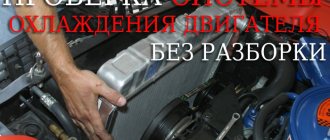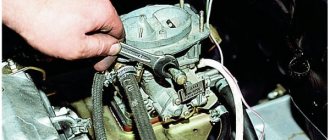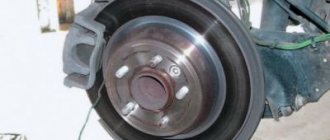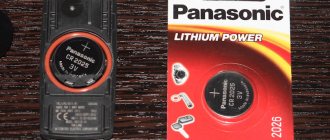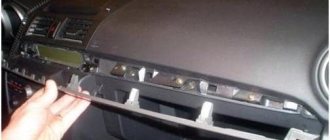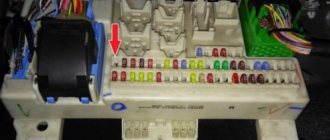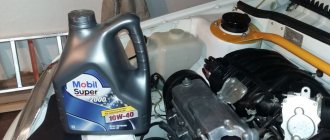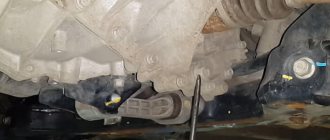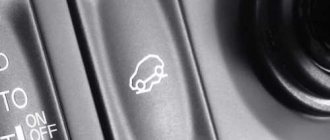System indicator (Red)
Intelligent City Braking Assist (SCBS)
When the advanced SCBS system is operating, the corresponding indicator (red) flashes.
Collision Warning
If there is a risk of a collision with a vehicle ahead, a continuous warning tone sounds and a warning appears in the multi-information display or the active driver display.
Active Driver Display
You can change the sensing distance and volume level of the collision warning signal. For more information, see pages 9-12 (“Customizing Settings”).
When the vehicle is braked by the advanced SCBS system or the emergency brake assist is activated (commanded by the advanced SCBS system), the warning “SCBS Automatic” appears on the multi-information display. braking." (SCBS Automatic Brake.).
During Enhanced SCBS braking or when the Advanced Brake Assist is activated by Enhanced SCBS, the Collision Alarm sounds intermittently.
If the vehicle is stopped by the Advanced SCBS system and the brake pedal is not pressed, after approximately 2 seconds a beep will sound once and the Advanced SCBS system will release the brakes.
The Japanese crossover of the CX-5 model range is equipped with modern safety features. The manufacturer paid special attention to the development of new methods that can reduce the likelihood of accidents on the road. To this end, the brand equipped the Mazda CX-5 with the SCBS system, which ensures safe braking of the car in city driving conditions.
Operating principles of SCBS
The operating principle of the City Braking System (SCBS) is based on the recognition of oncoming obstacles and the automatic application of the brake pedal. Infrared sensors on the windshield detect obstacles at a distance of 6 meters, and if the driver does not try to avoid them, the program begins to build up pressure in the brake system, helping to carry out an emergency stop of the car. Once the danger has passed, the system releases the pressure levers and the vehicle returns to normal operation.
Attention! SCBS can completely prevent an accident at a speed of 15 km/h and significantly reduce its consequences at 30 km/h.
If the on-board computer displays information about a Mazda SCBS malfunction, it is better to play it safe and go to a service station, as problems with the braking mechanisms can lead to an accident.
Manufacturer's recommendations
For the program to function properly, it is recommended to disable the SCBS system of the Mazda CX-5 while driving off-road. There are also several rules that must be followed to ensure correct operation of SCBS:
- all wheels must have the same tires, suitable for the standard size;
- the luggage compartment must not be overloaded;
- It is necessary to promptly clean the windshield from dirt.
The sensitivity of the sensor may decrease due to:
- bad weather;
- high level of pollution of a car moving towards you.
The safety braking system will operate normally provided that:
- trouble-free operation of the motor;
- no software errors;
- driving at speeds from 4 to 30 km/h;
- functioning of the traction control and anti-skid system;
- ride on high-quality and unworn tires.
Mazda cars are rightfully considered one of the most reliable in the world, and the latest safe braking system in the city is proof of this. If the SCBS sensor is working properly, the risk of accidents on the road is minimized.
Nothing, as they say, was foreshadowed, but what happened happened. While driving in a traffic jam, a “garland” suddenly lit up on the dashboard and the car’s transmission went into emergency mode. Errors on the dash: TPMS system check required Engine check required SCBS system check required
How does the safety braking system work?
The Japanese crossover of the CX-5 model range is equipped with modern safety features. The manufacturer paid special attention to the development of new methods that can reduce the likelihood of accidents on the road. To this end, the brand equipped the Mazda CX-5 with the SCBS system, which ensures safe braking of the car in city driving conditions.
Operating principles of SCBS
The operating principle of the City Braking System (SCBS) is based on the recognition of oncoming obstacles and the automatic application of the brake pedal. Infrared sensors on the windshield detect obstacles at a distance of 6 meters, and if the driver does not try to avoid them, the program begins to build up pressure in the brake system, helping to carry out an emergency stop of the car. Once the danger has passed, the system releases the pressure levers and the vehicle returns to normal operation.
Attention! SCBS can completely prevent an accident at a speed of 15 km/h and significantly reduce its consequences at 30 km/h.
If the on-board computer displays information about a Mazda SCBS malfunction, it is better to play it safe and go to a service station, as problems with the braking mechanisms can lead to an accident.
Possible faults
In the manual, the manufacturer warns the car owner about the possible causes of SCBS Mazda CX-5 errors. So, the program can be unbalanced by:
- stickers on the windshield that interfere with the sensor’s operation;
- windshield damage;
- replacing the windshield or wiper blades yourself;
- changing the suspension design (deviation of the body angle disrupts the functioning of the safety system).
Important! Disassembling the laser sensor, installing and dismantling it is permitted only at service stations of an authorized dealer.
If the message “SCBS check required” suddenly appears on the on-board computer screen, it is advisable to send the Mazda CX-5 for diagnostics.
Manufacturer's recommendations
For the program to function properly, it is recommended to disable the SCBS system of the Mazda CX-5 while driving off-road. There are also several rules that must be followed to ensure correct operation of SCBS:
- all wheels must have the same tires, suitable for the standard size;
- the luggage compartment must not be overloaded;
- It is necessary to promptly clean the windshield from dirt.
The sensitivity of the sensor may decrease due to:
- bad weather;
- high level of pollution of a car moving towards you.
The safety braking system will operate normally provided that:
- trouble-free operation of the motor;
- no software errors;
- driving at speeds from 4 to 30 km/h;
- functioning of the traction control and anti-skid system;
- ride on high-quality and unworn tires.
Bottom line
Mazda cars are rightfully considered one of the most reliable in the world, and the latest safe braking system in the city is proof of this. If the SCBS sensor is working properly, the risk of accidents on the road is minimized.
MRCC with Stop & Go functionality is designed to maintain driving control*1 with the vehicle in front according to your vehicle's speed using a radar sensor (front) to determine the distance to the vehicle in front and the vehicle's target speed without you having to use the accelerator or brake pedal .
- Headway Control: Monitors the distance between your vehicle and the vehicle in front as detected by Mazda Radar Cruise Control (MRCC).
In addition, if your vehicle begins to approach the vehicle in front, for example, if the vehicle in front suddenly brakes, an audible alarm and a warning display simultaneously appear on the display to alert you to maintain sufficient distance between the vehicles.
If the vehicle in front stops and you follow, your vehicle will stop and be stopped automatically (stop hold control), and pitch control will resume when you continue driving, for example by pressing the RES switch.
Please also read the following information before using the MRCC with the Stop & Go function.
Do not rely entirely on MRCC with Stop & Go function:
MRCC with Stop & Go functionality has detection limitations depending on the type of vehicle ahead and its conditions, weather and road conditions. Additionally, the system may not be able to decelerate sufficiently to avoid a collision with the vehicle ahead if the vehicle ahead is a vehicle ahead suddenly applies the brakes or another vehicle veers into the lane, which can result in an accident.
Always drive carefully, check your surrounding conditions, and apply the brake or accelerator pedal while maintaining a safer distance from vehicles ahead or oncoming vehicles.
Do not use the MRCC with the Stop & Go function system in the following places, using the MRCC with the Stop & Go function system in the following places may cause an unexpected accident:
- Public roads other than motorways (Driving in these conditions using the MRCC with Stop & Go function is not possible.)
- Roads with sharp turns, heavy vehicle traffic and insufficient space between them.
- Roads where frequent and repeated accelerations and decelerations occur (driving in these conditions using an MRCC with Stop & Go functionality is not possible).
- When entering and exiting interchanges, service areas and parking lots on highways (if you exit a highway while traffic control is in use, the vehicle ahead will no longer be tracked and your vehicle may accelerate beyond the speed limit).
- Slippery roads, such as icy or snowy roads (The tires may spin, causing you to lose control of the vehicle, or the stop button may not operate.)
- Long downhill slopes (to maintain the distance between vehicles, the system automatically and continuously applies the brakes, which may result in loss of braking force).
- Steep slopes (the vehicle ahead may not be detected correctly, your vehicle may slide when stopped using the stop button, and it may suddenly accelerate after starting to move.)
For your safety, turn off the MRCC with Stop & Go functionality when not in use.
Do not get out of the car while the stop button is working:
Exiting the vehicle while the Stop & Go control is engaged is dangerous as the vehicle may move unexpectedly and cause an accident. Before exiting the vehicle, turn off the MRCC with Stop & Go function, move the selector lever to position P and apply the Electric Parking Brake (EPB). ).
If your vehicle is being towed or you are towing something, turn off the MRCC with Stop & Go function to prevent improper operation.
- MRCC with Stop & Go functionality does not recognize the following objects as physical.
Vehicles approaching from the opposite direction
- Pedestrians
- Stationary objects (stopped cars, rubble)
- If the vehicle ahead is traveling at a very low speed, the system may not detect it correctly.
,
| Spark plug | Replace every 120,000 km (75,000 miles). | ||||||||
| Air filter | Replace at any equivalent engine oil change interval. (Maximum interval: 36 months or 60,000 km (37,500 miles)) | ||||||||
| Drive belts | I | I | |||||||
| Engine oil and filter * 1 | Replace when the spanner light is on. (Maximum interval: 12 months or 12,000 km (7,500 miles)) | ||||||||
| Engine coolant * 2 | Replace first 192,000 km (120,000 miles) or 10 years; thereafter every 96,000 km (60,000 miles) or 5 years. | ||||||||
| Fuel lines and hoses * 3 | I | I | I | I | |||||
| Emission hoses and tubes * 3 | I | I | |||||||
| Brake lines, hoses and connections | I | I | I | I | |||||
| Disc brakes | I | I | I | I | I | I | I | I | |
| Tire (rotation) | Crank at any equivalent engine oil change interval. (Maximum interval: 12,000 km (7,500 miles)) | ||||||||
| Steering and traction | I | I | I | I | |||||
| Front and rear suspension, ball joints and wheel bearing end play | I | I | I | I | |||||
| Rear differential oil | * 4 | ||||||||
| Transfer oil | * 4 | ||||||||
| Drive shaft boots | I | I | I | I | |||||
| Bolts and nuts on the chassis and body | T | T | T | T | |||||
| Exhaust system and heat shields | I | ||||||||
| Emergency tire deflation kit (if installed) * 5 | Inspect annually. | ||||||||
| Cabin filter | Replace at any equivalent engine oil change interval. (Maximum interval: 24 months or 48,000 km (30,000 miles)) | ||||||||
.
Do not drive if you smell exhaust fumes inside the vehicle:
Engine exhaust gases are dangerous. This gas contains carbon monoxide (CO), which is colorless, odorless and poisonous. If inhaled, may cause loss of consciousness and death. If you smell exhaust fumes inside the vehicle, keep all windows fully open and contact your Mazda dealer immediately.
Do not run the engine indoors:
Starting the engine in an enclosed area, such as a garage, is dangerous. Exhaust fumes containing poisonous carbon monoxide can easily enter the vehicle. Loss of consciousness or even death is possible.
Open the windows or adjust the heating or cooling system to allow fresh air to flow into the engine when idling:
Exhaust fumes are dangerous. When stopping a vehicle with the windows closed and the engine running for a long time, even in an open area, exhaust gases containing poisonous carbon monoxide can enter the cabin. Loss of consciousness or even death is possible.
Clear snow from underneath and around your vehicle, especially the exhaust pipe, before starting the engine:
Starting the engine while stopping the car in deep snow is dangerous. The exhaust pipe may have been blocked by snow, allowing exhaust gases to enter the cabin. Because exhaust fumes contain poisonous carbon monoxide, they can cause unconsciousness or even death to passengers inside.
,
